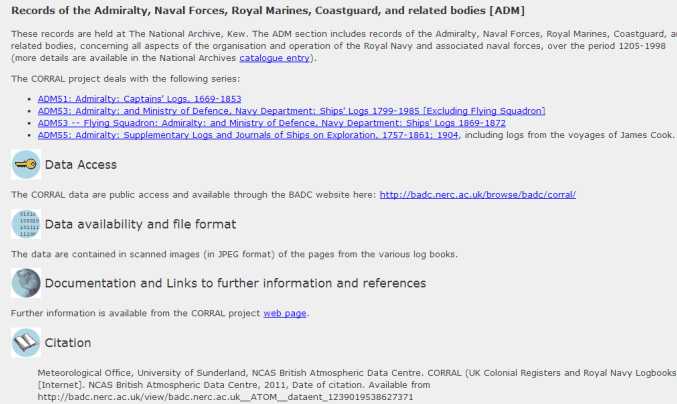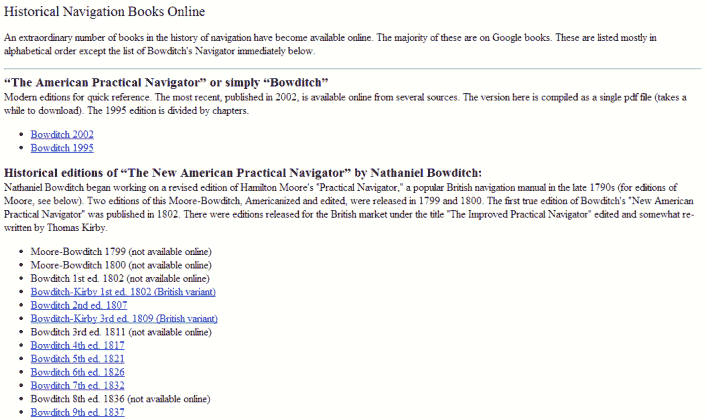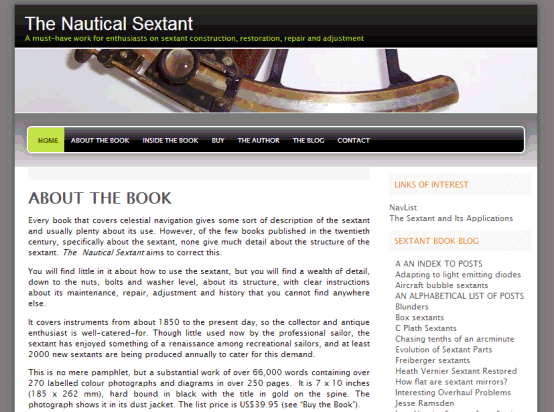
NavList:
A Community Devoted to the Preservation and Practice of Celestial Navigation and Other Methods of Traditional Wayfinding
Simple celestial navigation in 1897
From: Dave Walden
Date: 2006 Mar 2, 15:43 -0800
Yahoo! Mail
Bring photos to life! New PhotoMail makes sharing a breeze.
From: Dave Walden
Date: 2006 Mar 2, 15:43 -0800
I took Frank Reed's message of 25 Feb, "Simple celestial navigation in 1897", as a subtle but interesting challenge. I took a page at random from the workbook he references, page 30, and attempted to understand/explain/recreate all the figures included. Corrections, additions, comments are invited. (Or did I miss the boat completely?)
First, there seems to be, in fact three separate sight reductions on the page. (The lines and boxes don't seem to accurately separate the three calculations, so they may have been added
later.)
Taking only the first and uppermost calculation, I first transcribe the handwritten numbers below for easier reference:
___________________________________________________________________________
6 32"50 33"03 11"04"09
1"41 12 04379 7" 8
_______ _____ ________
6 34"31 33"15 00825 11"11"17
25"18 24677 2"34
101"08 86116 ________
______ _____ 11"08"43
129"33 159"41 15997 90
______ _____
________
Feb 19th 1897 79"50 101"08"43
33"15
______
46"35 2"58"46
13"58
_________
15"12"44
6"34"31
_________
8"38"13
___________________________________________________________________________
After some guessing and iterating, using the fact that the Morgan is likely in the North Pacific at this time, I take 6"34"31 to be GMT (chronometer + correction), 25"18 to be Latitude North, 129"33 to be the final result for Longitude East. Using this date (obvious), time, Latitude, and Longitude, I go the USNO online navigation site, and get the following:
___________________________________________________________________________
U.S. Naval Observatory
Astronomical Applications Department
Celestial Navigation Data
Celestial Navigation Data for 1897 Feb 19 at 6:34:31 UT
For Assumed Position: Latitude N 25 18.0
Longitude E 129 33.0
Almanac Data | Altitude Corrections
Object GHA Dec Hc Zn | Refr SD PA Sum
o ' o ' o ' o | ' ' ' '
SUN 275 07.7 S11 09.2 +33 14.0 235.6 | -1.5 16.2 0.1 14.8
__________________________________________________________________________
Things are now looking very good. The USNO's Sun's declination South, of 11 09.2 is close to the 1897 value of 11"08"43 (almanac 11"04"09 + 7"8, correction for 8 hours after tabulated time (=the daily difference /3) - 2"34 correction for 1hr 26min less than 8 hours after tabulated time).
The USNO's calculated altitude, +33 14.0, is close to the 1897 observation of 33"15 (33"03 from the sextant + "12, the 'universal' refraction+dip+semi-diameter correction described by Frank Reed) ((Close to the USNO value of 14.8' without dip correction))
Now, for the actual meridian angle calculation using the 'time sight' method. The equation used here is:
hav t = sec L csc p cos s sin(s-h)
where:
hav=haversine (also useful is hav=(1-cos)/2
sec=secant (sec=1/cos)
csc=cosecant (csc=1/sin)
cos=cosine
sin=sine
h=altitude
t=meridian angle
L=Latitude
d=declination
p=90-d if L and d same name
p=90+d if L and d contrary name
s=1/2 (h+L+p)
We recognize 101"08"43 on the far right bottom as p=90+d.
159"41 is 2 times s or (H+L+p) listed just above as: 33"15, 25:18, and 101"08 transferred from the far right bottom.
79"50 is 159"41 divided by 2 or
s.
Below 79"50, 33"15 is repeated from above to facilitate calculation of the needed (s-h).
46"35 is s-h.
Now for some table (Bowditch Table 44 and 45 seem possible) look-ups (but only 4 entries for natural to log, and 1 for log to natural!) The use of the formula above has the significant advantage of including NO addition of subtraction, so one only switches to logs once to multiply, then back for the answer and you're done.
So, starting at the top of the third column, 04379 is 100,000 times the log base 10 of sec L. In detail by calculator for the first one:
L=25"18=25+18/60=25.30 deg or 25.3*pi/180=.4415683 radians
cos L= 0.90408255
sec L=1/cos L=1.1060937
log10
1.1060934=.0437919
100,000*.0437919=4379 to 4 digits
00825 is 100,000 times log10 csc p.
24677 is 100,000 times [(log10 cos s)+1], the +1, the standard method to avoid negative logs.
86116 is 100,000 times [(log10 sin(s-h)+1].
15997 is the sum of the logs, which gives the log of the product.
Entering the log to natural haversine table with 15997 yields 2"58"46 in hour, minute, second notation. Useful equation for calculators; if x=hav t, t=acos(1-2x).
13"58 must be the almanac value for the equation of time, needed for mean to apparent sun. USNO above, gives GHA of Sun as 275-7.7 at 6:34:31 UT 2/19/1897 . Convert 275-7.7 degrees to time, subtract 12+GMT gives equation of time=14-0.
12hr=180deg is added as required by "the rule" (it's not written down; neither the rule nor the 12).
The GMT 6"34"31 transferred from above is subtracted, giving the final answer for longitude, 8"38"13 in hours, minutes, seconds. Times 15 for degrees gives:
8+38/60+13/3600=8.636944
8.636944*15=129.5541deg=129deg-33min
QED.
Ref: Bowditch 1962, Cugle 1936 (a great book, ?underappreciated?).
Yahoo! Mail
Bring photos to life! New PhotoMail makes sharing a breeze.






